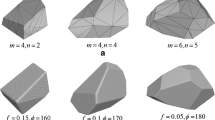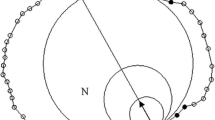Abstract
Passing ability is an important property of self-compacting concrete (SCC). Blockage due to poor passing ability leads to the formation of voids, thereby creating weak areas in concrete structure. Moreover, the aggregate morphology greatly influences the passing ability of fresh SCC. In this study, the 3D laser scanning technology and the digital image processing technology were used to quantitatively characterize the aggregate morphology. The aggregate Clump model with natural morphology was generated using the Bubble Pack algorithm. Also, a virtual aggregate database was built, and a 3D discrete element modeling framework for J-Ring test based on the adhesive rolling resistance linear model was proposed. On this basis, the effects of sphericity from 0.5 to 0.9, angularity index from 250 to 650, and rebar spacing from 37.7 to 79.5 mm on the passing ability of SCC were quantitatively analyzed, and the blockage mechanism of SCC was discussed from the meso-scale level. The results show that blockage in SCC is a probabilistic event. The existence of flaky, elongated and multi-angular aggregates increases the possibility of forming granular arches, and the closer the aggregate is to a sphere or the smoother the surface contour, the better the passing ability of fresh SCC. However, when the sphericity index is greater than 0.8, the angularity index is greater than 550, and the rebar spacing is greater than three times the maximum aggregate size, the effect of aggregate morphology or rebar spacing on the passing ability of SCC is not significant.












Similar content being viewed by others
References
Okamura H (1997) Self-compacting high-performance concrete Concrete international. Concr int 19(7):5054
Shi C, Wu Z, Lv KX et al (2015) A review on mixture design methods for self-compacting concrete. Constr Build Mater 84:387–398
Sonebi M, Grünewald S, Walraven J (2007) Filling ability and passing ability of self-consolidating concrete. ACI Mater J 104(2):162
Hosseinpoor M, Khayat KH, Yahia A (2017) Numerical simulation of self-consolidating concrete flow as a heterogeneous material in L-Box set-up: coupled effect of reinforcing bars and aggregate content on flow characteristics. Mater Struct 50(2):1–15
Roussel N, Nguyen TLH, Yazoghli O et al (2009) Passing ability of fresh concrete: a probabilistic approach. Cem Concr Res 39(3):227–232
Ling SK, Kwan AKH (2015) Adding ground sand to decrease paste volume, increase cohesiveness and improve passing ability of SCC. Constr Build Mater 84:46–53
Ammar Y, Kamal KH, Mohammed S (2012) Statistical modelling of the coupled effect of mix design and rebar spacing on restricted flow characteristics of SCC. Constr Build Mater 37:699–706
Nepomuceno MCS, Pereira-de-Oliveira LA, Lopes SMR et al (2016) Maximum coarse aggregate’s volume fraction in self-compacting concrete for different flow restrictions. Constr Build Mater 113:851–856
Khaleel OR, Al-Mishhadani SA, Razak HA (2011) The effect of coarse aggregate on fresh and hardened properties of self-compacting concrete (SCC). Procedia Engi 14:805–813
Pandurangan K, Ramakrishna G, Kothandaraman S (2012) Effect of coarse aggregate size and shape on the strength and flow characteristics of self-compacting concrete. ICI Journal. 1(7)
Hosseinpoor M, Koura BIO, Yahia A (2021) New diphasic insight into the restricted flowability and granular blocking of self-consolidating concrete: effect of morphological characteristics of coarse aggregate on passing ability of SCC. Constr Build Mater 308:125001
Krumbein WC (1941) Measurement and geological significance of shape and roundness of sedimentary particles. J Sediment Res 11(2):64–72
Liang Z, Nie Z, An A et al (2019) A particle shape extraction and evaluation method using a deep convolutional neural network and digital image processing. Powder Technol 353:156–170
Aragão FTS, Pazos ARG, da Motta LMG et al (2016) Effects of morphological characteristics of aggregate particles on the mechanical behavior of bituminous paving mixtures. Constr Build Mater 123:444–453
Liu Y, Gong F, You Z et al (2018) Aggregate morphological characterization with 3D optical scanner versus X-ray computed tomography. J Mater Civ Eng 30(1):04017248
Ostrowski K, Oleksik K (2018) Comparative analysis of the coarse aggregate shapes used to manufacturing high performance self-compacting concrete. Tech Trans 11(7):75–86
Zhao L, Zhang S, Huang D et al (2020) 3D shape quantification and random packing simulation of rock aggregates using photogrammetry-based reconstruction and discrete element method. Constr Build Mater 262:119986
Ma K, Huang X, Shen J et al (2021) The morphological characteristics of brick-concrete recycled coarse aggregate based on the digital image processing technique. J Build Eng 44:103292
Lu G, Third JR, Müller CR (2015) Discrete element models for non-spherical particle systems: from theoretical developments to applications. Chem Eng Sci 127:425–465
Roussel N, Spangenberg J, Wallevik J et al (2020) Numerical simulations of concrete processing: from standard formative casting to additive manufacturing. Cem Concr Res 135:106075
Mechtcherine V, Gram A, Krenzer K et al (2014) Simulation of fresh concrete flow using discrete element method (DEM): theory and applications. Mater Struct 47(4):615–630
Remond S, Pizette P (2014) A DEM hard-core soft-shell model for the simulation of concrete flow. Cem Concr Res 58:169–178
Zhang X, Li Z, Zhang Z et al (2018) Discrete element analysis of the rheological characteristics of self-compacting concrete with irregularly shaped aggregate. Arab J Geosci 11(19):1–17
Zhang J, Xu P, Gao X (2021) Multi-scale particles optimization for some rheological properties of Eco-SCC: modelling and experimental study. Constr Build Mater 308:125151
Zhang X, Li Z, Zhang Z (2017) Blocking mechanism scxstudy of self-compacting concrete based on discrete element method. IOP conference series: materials science and engineering, IOP Publishing, 269(1):012090
Cui W, Yan W, Song H et al (2018) Blocking analysis of fresh self-compacting concrete based on the DEM. Constr Build Mater 168:412–421
Cui W, Yan W, Song H et al (2020) DEM simulation of SCC flow in L-Box set-up: influence of coarse aggregate shape on SCC flowability. Cem Concr Compos 109:103558
Wang F, Xiao Y, Chen Z et al (2022) Morphological characteristics of mineral filler and their influence on active adhesion between aggregates and bitumen. Constr Build Mater 323:126520
Ma G, Xie Y, Long G et al (2022) Mesoscale investigation on concrete creep behaviors based on discrete element method. Constr Build Mater 342:127957
Kwan AKH, Mora CF, Chan HC (1999) Particle shape analysis of coarse aggregate using digital image processing. Cem Concr Res 29(9):1403–1410
Bhattacharya S, Subedi S, Lee SJ et al (2020) Estimation of 3D sphericity by volume measurement–application to coarse aggregates. Transportation Geotechnics 23:100344
Zhao Y, Duan Y, Zhu L et al (2021) Characterization of coarse aggregate morphology and its effect on rheological and mechanical properties of fresh concrete. Constr Build Mater 286:122940
Pouranian MR, Shishehbor M, Haddock JE (2020) Impact of the coarse aggregate shape parameters on compaction characteristics of asphalt mixtures. Powder Technol 363:369–386
Ozturk HI, Rashidzade I (2020) A photogrammetry based method for determination of 3D morphological indices of coarse aggregates. Constr Build Mater 262:120794
Li W, Wang D, Chen B et al (2022) Research on three-dimensional morphological characteristics evaluation method and processing quality of coarse aggregate. Buildings 12(3):293
Rao C, Tutumluer E, Kim IT (2002) Quantification of coarse aggregate angularity based on image analysis. Transp Res Rec 1787(1):117–124
Wu J, Zhou X, Zeng X et al (2022) Effect of aggregate morphology characteristics on the voidage of aggregate loose packing based on 3D discrete element method. Constr Build Mater 348:128598
Taghavi R (2011) Automatic clump generation based on mid-surface. Proceedings, 2nd international FLAC/DEM symposium, Melbourne, 791–797
Zhou X, Xie Y, Long G et al (2021) Effect of surface characteristics of aggregates on the compressive damage of high-strength concrete based on 3D discrete element method. Constr Build Mater 301:124101
Shin SS (2020) Structured query language learning: concept map-based instruction based on cognitive load theory. IEEE Access 8:100095–100110
Keke S, Xiaoqin P, Shuping W et al (2019) Design method for the mix proportion of geopolymer concrete based on the paste thickness of coated aggregate. J Clean Prod 232:508–517
Zhou X, Xie Y, Long G et al (2021) DEM analysis of the effect of interface transition zone on dynamic splitting tensile behavior of high-strength concrete based on multi-phase model. Cem Concr Res 149:106577
Sinaie S (2017) Application of the discrete element method for the simulation of size effects in concrete samples. Int J Solids Struct 108:244–253
Xue B, Pei J, Zhou B et al (2020) Using random heterogeneous DEM model to simulate the SCB fracture behavior of asphalt concrete. Constr Build Mater 236:117580
Gilabert FA, Roux JN, Castellanos A (2008) Computer simulation of model cohesive powders: plastic consolidation, structural changes, and elasticity under isotropic loads. Phys Rev E 78(3):031305
Cundall PA, Strack ODL (1979) A discrete numerical model for granular assemblies. Geotechnique 29(1):47–65
Ai J, Chen JF, Rotter JM et al (2011) Assessment of rolling resistance models in discrete element simulations. Powder Technol 206(3):269–282
Wensrich CM, Katterfeld A (2012) Rolling friction as a technique for modelling particle shape in DEM. Powder Technol 217:409–417
Zhou X, Xie Y, Long G et al (2023) Simulating passing ability of self-compacting concrete in the J-Ring test using cohesive particle liquid bridge model. Powder Technol 416:118218
Zhang S, Zhang C, Liao L et al (2018) Numerical study of the effect of ITZ on the failure behaviour of concrete by using particle element modelling. Constr Build Mater 170:776–789
Elliott AC, Hynan LS (2011) A SAS® macro implementation of a multiple comparison post hoc test for a Kruskal-Wallis analysis. Comput Methods Programs Biomed 102(1):75–80
Gu X, Jia J, Wang Z et al (2013) Determination of mechanical parameters for elements in meso-mechanical models of concrete. Front Struct Civ Eng 7(4):391–401
Zia P, Nunez RA, Mata LA et al (2005) Implementation of self-consolidating concrete for prestressed concrete girders, NC Department of Transportation, Research and Analysis Group
Acknowledgements
This work was supported by the National Natural Science Foundation of China (No. 52078490). The authors acknowledge this support.
Author information
Authors and Affiliations
Corresponding author
Additional information
Publisher's Note
Springer Nature remains neutral with regard to jurisdictional claims in published maps and institutional affiliations.
Rights and permissions
Springer Nature or its licensor (e.g. a society or other partner) holds exclusive rights to this article under a publishing agreement with the author(s) or other rightsholder(s); author self-archiving of the accepted manuscript version of this article is solely governed by the terms of such publishing agreement and applicable law.
About this article
Cite this article
Zeng, X., Wu, J., Zhou, X. et al. Numerical investigation on the passing ability of fresh self-compacting concrete with different aggregate morphology using cohesive particle liquid bridge model. Mater Struct 56, 104 (2023). https://doi.org/10.1617/s11527-023-02192-y
Received:
Accepted:
Published:
DOI: https://doi.org/10.1617/s11527-023-02192-y




